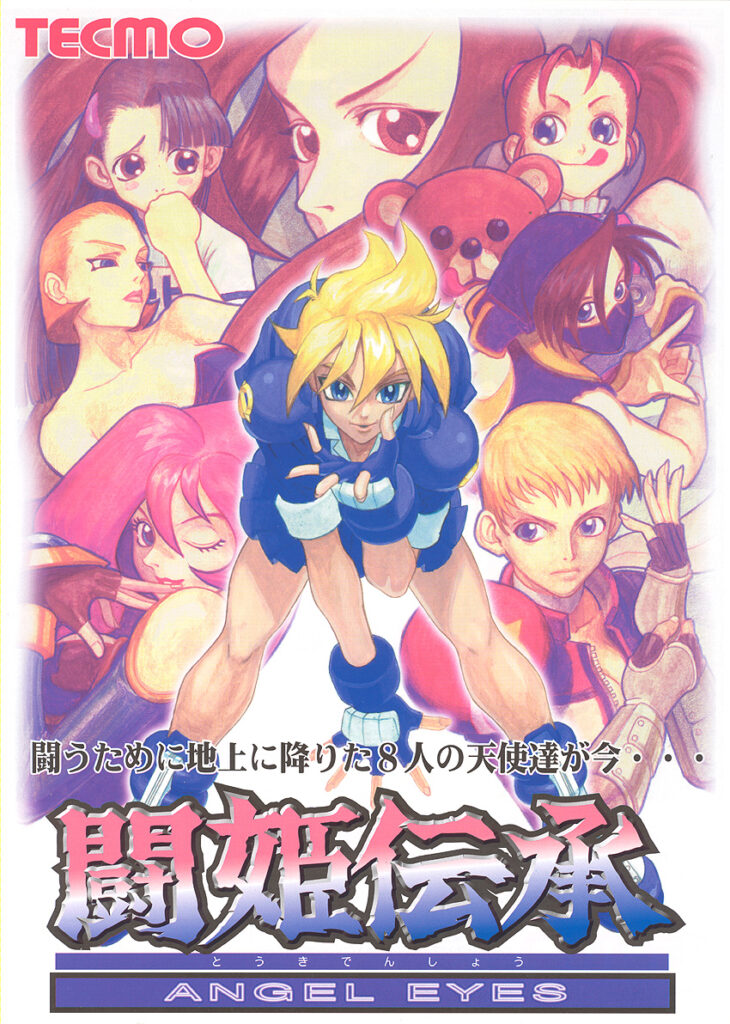October 13th, 8:42am, Twitter account @ohfivepro posts what looks to be a screenshot of a video confirming that Tōkidenshō Angel Eyes is coming to Switch and Ps4 via Arcade Archives on October 20th. Adulation of this news courses through the comments and the QRTs on the original tweet, as it is not only that Angel Eyes is coming to home consoles, but that it is finally coming home. Announced on Sept 10th 2020, it has been over two years with no update as to where the release is. This, alongside the similarly-updatedless Complete Edition of Daraku Tenshi, was considered to be possibly dead in the water by some given the radio silence after its initial announcement. But now that we have a date to expect it on; what is Tōkidenshō Angel Eyes and why are people so excited to see a home console port of it show up?
More Dead, Less Alive
Tōkidenshō Angel Eyes (henceforth just referred to as “Angel Eyes”) was a 1996 fighting game birthed from Tecmo’s early 90s struggle era. After Ninja Gaiden II for the Neo Geo was quietly deemed a failure and did not see release, the plan was to make a fighting game by reusing the assets. Three teams were made to craft up something based on three different pitches: a fairytale themed fighting game, a horseback based fighting game, and what won out in the end, a ninja themed fighting game. Tecmo’s first fighting game was off to the races.
And then the problems started. In Sept 1994, Tecmo’s president, Kakihara Yoshihito, announced that the company would be making a fighting game for the Sega Model 2, but the Angel Eyes team was not the one to be working on it. This became a shadow over Angel Eyes as the Sega Model 2 game ended up being arcade smash hit Dead Or Alive. Shortly after this announcement the Angel Eyes team dropped the ninja concept for a new coat of paint; a Bishoujo fighting game (I seem to be talking about these a lot lately). Once 1995 had started the team was on a good pace with the code but the artwork was dragging behind. Because the artwork wasn’t on track with everything else, the unused sprites of Ran from the failed Ninja Gaiden II Neo Geo was the test character for most of the development.
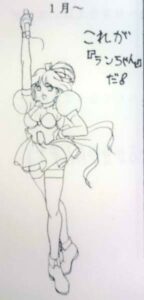
For a while, everyone in Angel Eyes looked like this. Not a complaint if I’m being honest.
The character art wasn’t the only problem, the Angel Eyes team had started small and was getting smaller. Programmer Miyazaki Eigo was moved off the Angel Eyes team to somewhere else, and with his name showing up in the Dead or Alive credits it’s pretty easy to assume he was poached to work for the title Tecmo was looking a bit more focused on. Looking at MobyGames, the Dead or Alive team practically doubled the size of the Angel Eyes team. According to Hasanuma Jun the Planner most of this information comes from, the upper management had started to apply some pressure on the team as well, saying quote “If this game doesn’t sell, who knows what’s going to happen to you all!”
Long story short, the Angel Eyes development was not a smooth one. It was constantly overshadowed by the size of Tecmo’s soon-to-be cash cow and its artistic struggles could have led to its…interesting let’s call it, visual design. Between the two games, most people are going to know Dead or Alive over Angel Eyes, but those who are familiar with Angel Eyes (and are not deranged kusoge lab monsters) probably know it for its strange mixed media approach to characters.
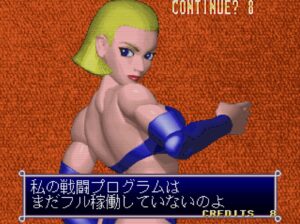
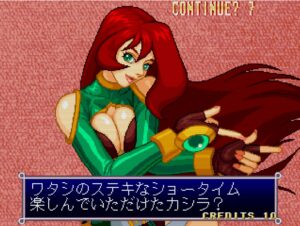
One of these things is not like the other one.
Characters like the spunky protagonist Raiya, motorcycle badass Highway Star, and Boobzilla McTits-a-lot Mysterious Power are all done in traditional sprite based animation. However characters like rival girl Reika, kunoichi Kiriko, and metallic clanking cyborg woman Lina are done in a digitized 3D model style similar to how Donkey Kong Country looks. This clash of styles immediately sets Angel Eyes apart from the pack because it almost comes off like some sort of Marvel vs Capcom 2 release with art from different sources slapped together. It makes the game look like a janky incomplete mess, but from what I can tell this was some sort of purposeful move? The eventual home port for the Ps1 contains hand-drawn versions of the 3D rendered characters, so it’s unsure what the true intention of the style was for. I remember hearing a rumor back in the day (and I have no source for this so do not take it as truth) that the team was in such a bad state during development that half of the crew doing the character art thought it was supposed to be 2D and the other half thought it was supposed to be 3D and once they got back together they realized they had two separate styles of work done. While unfounded, it’s not impossible given how troubled development was.
With all these tales of woe, one might expect that Angel Eyes is a bit of a mess to play. After all, it was just riddled with problems when in development. But here’s where I flip the script on you because Tōkidenshō Angel Eyes is wildly ahead of its time and features multiple mechanical choices that are straight-up giga-brained.
Reverse Damage Scaling And You: A Guide To Understanding Angel Eyes
How do you start talking about Angel Eyes mechanics? It’s like diving into a dark pool, unable to see the bottom of what it contains. 2 years before the first Guilty Gear and a whole fucking decade before the first Arcana Heart; Angel Eyes is one of the foundational anime fighters in the airdasher style. Angel Eyes is manic with airborne options, jumps are given out like a stop on the all-you-can-eat buffet and mobility exists at a speed somewhere between Monster Energy Enters The Cocaine Market and Star Trek Teleporters. Not only that but Angel Eyes is one of the only games I can think of that refuses to let you play neutral, the start of every round sees your girls fly into the skies like Dragonball Z characters and start the battle by clashing into each other. But what makes this game truly diabolical is how it ate Arcana Heart’s lunch with homing jumps. You can spend an air action to blitz across the screen towards your opponent and maintain the pressure. The speed and minimum height required is so bananas that you can take a can opener to your opponent’s defense in nearly instant fashion.
As offensively-minded as this may be, Angel Eyes has a very forward thinking defensive aspect packed in as well; air brake. You can air brake and briefly become invincible before taking another air action after you recover. In a move reminiscent of early Tekken, there are also no walls to speak of. Stages loop endlessly, never finding a corner for you to be backed into and mixed to death. Trust me, you will get mixed to death properly enough out in the open. However if you think this cavalier approach to movement and real estate would make for interesting zoning playstyles you would be, frankly, unambiguously, horrifically, catastrophically wrong. Projectiles can be negated or reflected depending on the strength of normal used and there is no speed faster than the homing dash. The furthest two players will be from each other is when they both homing dash and miss. There are a myriad of mechanics to Angel Eyes; the guard cancels, the fire and lighting states, the EMOTION super attacks, wall bounces, almost none of these will be seen in a typical tournament-level Angel Eyes match. One mechanic rules the game, to the point where other aspects of it’s gameplay become nearly obsolete
Reverse Damage Scaling.
Death comes from any angle, or any angel, both really.
See, typically, the longer a combo goes on for the less damage strikes will do. A jab that starts a combo may do 10 damage but at the end it may only do 4. This is because in almost every game, damage is calculated with a deterioration percentage. This prevents long combos from dealing too much damage, a noble pledge for a fighting game that looks to be taken in a serious balanced manner. Now, I cannot find the source on this but I have heard it repeated along these lines multiple times; one of the planners was very inexperienced with fighting games. They wanted to have the joy of doing big damage without the struggle of doing big combos. Enter Angel Eyes’ Reverse Damage Scaling (also called Reverse Combo Correction); unlike nearly every other fighting game under the sun, the longer your combo is the MORE damage every strike does.
This turns Angel Eyes into a lightning fast bloodbath. As early as the round start aerial clash, characters can do a Touch of Death combo if they get the hit. Rounds last an average of 10 normal human seconds as even if your first hit does not lead to an empty life bar, it doesn’t take much to homing dash mix someone for a two-touch. This is what makes Angel Eyes so magical, so desirable by kusoge-poisoned fighting gamers. The capacity to ToD someone is there waiting for you to pull it off and you are given all the break-neck movement skills necessary to do it. Rounds and games can blitz by at an unprecedented pace. Sure a savvy defensive player could extend the round by 5, maybe 10, seconds with some good blocks, but death is inevitable and it’s either kill or be killed in this game.
According to @OnemiESESEBEME the game can be played with lower damage to give you cooler combos. That’s right, the current damage system is so powerful that it actually gates the true combo potential in Angel Eyes.
Get or Get Got
It’s sad that Angel Eyes was practically DOA to DoA. Not only did Dead or Alive harm the game’s development, but Angel Eyes was only out for a couple months before DoA1 tore it up at the arcades and solidified Tecmo’s step into fighting games. The team was able to make a home port for the PlayStation 1 that had some extra bennies, like new versions of characters that almost exclusively play the same. There was even a fan doujin that includes development stories, a helpful tool in trying to piece together what happened during development, and it gives us the most information about the 9th character that was sadly cut from the game: a mysterious looking woman with a large snake around her. While the illustration mentions desire to bring her back for the home port of a sequel (her voice work was done but she was canned during animation), it was never to be. Many of the staff behind Angel Eyes were absorbed into Dead or Alive and worked on that franchise moving forward.
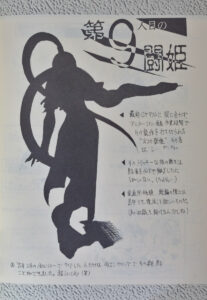
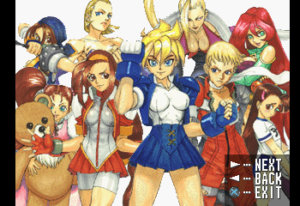
Thankfully we get an illustration of her in the PS1 CG Gallery. Oh how I dream of a world where we got Angel Eyes 2.
To the layperson, a game filled with such applicable 100% combos may sound like unbalanced garbage but it’s what makes Angel Eyes so special. The verticality of Marvel Versus games, the aerial mobility of the Arcana Heart series, and a line of coke that would cause a lesser game to have a Primal Rage health bar styled heart attack, there’s simply nothing else like it. Add on top of that the strange visual design and you have a game that is so unique among its peers that it has become a bit of a mythical beast. It sounds like a made-up game, like an urban rumor, but it’s very much real. Even when games like Arcana Heart came out and featured a homing dash, there was no way they were brazen enough to make it have the speed of Angel Eyes.
The Arcade Archives release marks the first time Tōkidenshō Angel Eyes will be truly available in the west. Both the arcade release and the PlayStation home port were exclusive to Japan, but savvy players could get the PS1 Angel Eyes off the JPN PSN for PS3 if they needed their fix (this is me, I did that). In a rather shocking move, it has been confirmed that the Arcade Archives release will have a additional practice mode, even if it is a bare bones one. With one of the largest barriers for learning out of the way, Tōkidenshō Angel Eyes is coming home fashionably late and with a couple bells and whistles picked up along the way. It is now widely accessible for people to bring Angel Eyes to locals and finish a bracket with land speed record timing, I wouldn’t have it any other way.
[Takes long drag from cigarette] Maybe it’s time to start that Angel Eyes wiki.
Editor’s Note: Angel Eyes has a wiki page on Mizuumi as of now!


